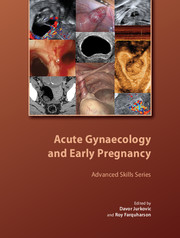Book contents
- Frontmatter
- Contents
- About the authors
- Acknowledgements
- Abbreviations
- Preface
- 1 Organisation and delivery of emergency care in early pregnancy and acute gynaecology
- 2 Epidemiology and aetiology of miscarriage and ectopic pregnancy
- 3 Diagnosis of miscarriage
- 4 Conservative and surgical management of miscarriage
- 5 Management of hyperemesis gravidarum
- 6 Diagnosis and treatment of recurrent miscarriage
- 7 Differential diagnosis and management of molar pregnancy
- 8 Drugs in early pregnancy
- 9 Diagnosis of tubal ectopic pregnancy
- 10 Conservative management of tubal ectopic pregnancy
- 11 Surgical management of tubal ectopic pregnancy
- 12 Diagnosis and management of non-tubal ectopic pregnancy
- 13 Diagnosis and management of acute pelvic pain
- 14 Management of vaginal bleeding in the acute clinical setting
- 15 Current concepts in screening and outpatient management of pelvic inflammatory disease
- 16 Diagnosis and management of haemorrhagic and septic shock
- 17 Role of minimally invasive surgery in acute gynaecology
- Index
12 - Diagnosis and management of non-tubal ectopic pregnancy
Published online by Cambridge University Press: 05 July 2014
- Frontmatter
- Contents
- About the authors
- Acknowledgements
- Abbreviations
- Preface
- 1 Organisation and delivery of emergency care in early pregnancy and acute gynaecology
- 2 Epidemiology and aetiology of miscarriage and ectopic pregnancy
- 3 Diagnosis of miscarriage
- 4 Conservative and surgical management of miscarriage
- 5 Management of hyperemesis gravidarum
- 6 Diagnosis and treatment of recurrent miscarriage
- 7 Differential diagnosis and management of molar pregnancy
- 8 Drugs in early pregnancy
- 9 Diagnosis of tubal ectopic pregnancy
- 10 Conservative management of tubal ectopic pregnancy
- 11 Surgical management of tubal ectopic pregnancy
- 12 Diagnosis and management of non-tubal ectopic pregnancy
- 13 Diagnosis and management of acute pelvic pain
- 14 Management of vaginal bleeding in the acute clinical setting
- 15 Current concepts in screening and outpatient management of pelvic inflammatory disease
- 16 Diagnosis and management of haemorrhagic and septic shock
- 17 Role of minimally invasive surgery in acute gynaecology
- Index
Summary
Introduction
The fallopian tube is the most common location for pregnancies that implant outside the uterine cavity. In the minds of the lay public and many health professionals, tubal implantation is often considered synonymous with ectopic pregnancy. However, there are many other locations within the pelvis and abdominal cavity where a pregnancy could implant and grow. Cases of ectopic pregnancy have been described affecting organs as distant as the liver or omentum. It has been reported that approximately 7% of all ectopic pregnancies are located outside the fallopian tubes. Such pregnancies are often referred to as non-tubal ectopic pregnancies.
In recent years the incidence of ectopic pregnancy has increased owing to many factors such as improved sensitivity of urine pregnancy tests, better ultrasound diagnosis, wide use of assisted reproductive techniques and, possibly, the increased incidence of tubal damage caused by pelvic inflammatory disease. In addition, the increase in the number of surgical procedures involving the uterus, in particular the high rate of caesarean sections, has played an important role in the higher number of both tubal and non-tubal ectopic gestations.
Although non-tubal ectopic pregnancies are relatively rare, they are associated with significantly higher maternal morbidity and mortality rates compared with tubal ectopic pregnancies. This is primarily because of their tendency to remain clinically silent in early gestation and to present with acute, severe symptoms either late in the first trimester or during the second trimester of pregnancy.
- Type
- Chapter
- Information
- Acute Gynaecology and Early Pregnancy , pp. 151 - 168Publisher: Cambridge University PressPrint publication year: 2011

